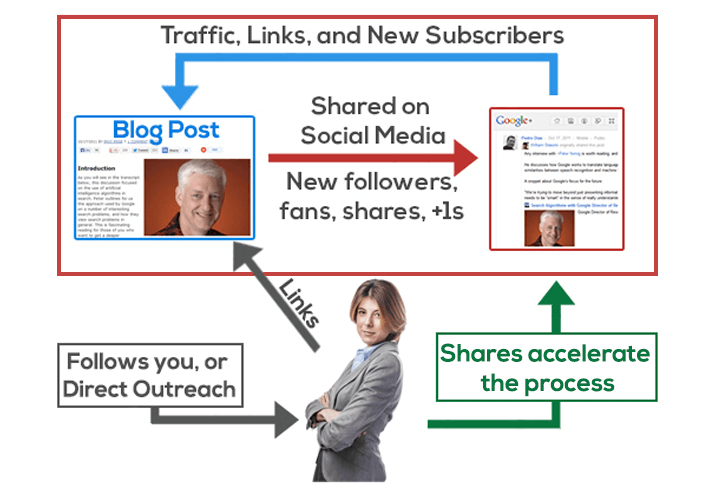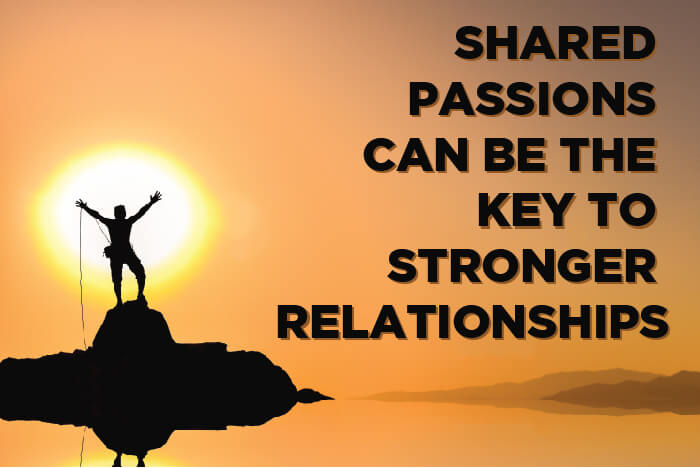
We all recognize that influencer relationships play a key role in any business or career plan. Finding and developing the right relationships helps you accelerate the progress towards your goals.
It’s also important to understand that some influencer relationships will be more important to you than others. I call these people “Anchor Influencers.”
What fuels these is a stronger sense of connection, stronger alignment in your view of the market, and perhaps even some level of personal connection. Choose these relationships wisely, as they are a key component of your overall marketing plan.
In today’s post, I’m going to discuss how you go about developing these relationships. I’m not going to spend that much time on the very basics of relationship building, as I plan to get quite a bit deeper into what drives Anchor relationships. I’ll also share several stories of creative strategies I have seen people employ.
This ability to benefit from Anchor Influencers holds true regardless of the size of your business. Anchor Influencers can help you accelerate the process of spreading your message and provide external validation and credibility, even if you are a larger brand. If you’ve got money, you can pay for their attention, of course; but obtaining their personal engagement and passion will still be invaluable.
One word I want you to lose from your vocabulary right at the start of this discussion is “leverage.” You ain’t gonna be leveraging no one (the awful English here is intentional). And that’s your first lesson. When pursuing Anchor Influencer relationships, the relationship is the positive outcome you are looking for — help with your business goals stems from that.
Content marketing and SEO benefits
Influencers who are engaged with your brand can be like rocket fuel for your content marketing efforts. The payoff is their active sharing of great content that you produce, which acts as third-party validation for that content and can cause others to share it and link to it.

What the above graphic shows is:
- If you create great content, sharing it in your social media channels will help those channels grow.
- If the content is linkworthy, then sharing it in social media channels can help it obtain additional shares and links.
- If influencers share it, they act as accelerants, due to their large audiences and the value of their independent validation.
This does depend on your creating the kind of content that is worth sharing and linking to, and that is by itself a difficult task. But if you’re able to do that, the influencer relationship helps you maximize the ROI of creating that content. From an SEO perspective, this comes in the form of high value links to your content.
The essential power of passion
Everything starts with your passion for what you do and openly sharing that love with people you encounter. This is definitely not a “fake it ’til you make it” conversation — the passion has to be real. Your expertise and passion will create unique opportunities for engagement with influencers who share that passion.

It’s also helpful to take stands on key issues in your market. These may be somewhat polarizing, but that is normally a good thing. Take, for example, Seventh Generation, a household products company that made its name by taking a strong stand on eco-friendliness. This eco-friendly focus is at the core of their brand identity, which allows them to communicate with passion and connect with others who share a similar point of view.
At Stone Temple Consulting, our passion is ethical, white-hat digital marketing (and SEO). It’s a message we’ve been broadcasting from the very early days of the company. You can see an example of that in this post I wrote on the Moz blog back in February 2008, “I Don’t Buy Links.”
Passion does many things for you, including these:
- Gives you and your employees a focus to rally around.
- Creates key points of connection with influencers who share those passions.
- Provides something to which others in the market can attach.
- Differentiates you from your competitors.
The raw basics of relationship building (quick recap):
This section is written on the assumption that you don’t have money to deploy in building your Anchor Influencer relationships. Even if you do have that available, bear in mind that money can sometimes interfere with the process, and the principles below still apply. Here are the basic steps:
- Follow the influencer everywhere they exist publicly online.
- Read everything they write and share.
- Find ways to add value with comments.
- Don’t ask anything of them.
- Don’t stalk them.
- Be incredibly patient.
- Know that the process may take six months, a year, or more.
- Wait for the right opportunity to arise to help them out, and then leap on it.
Your focus needs to be on helping them in a material way related to their interests in your market space, but that’s not the only component of building a relationship. Find ways to bring in who you are as a person outside of business into the picture, as well. When people learn about who you are as a person, that helps build trust. Take pains to learn more about them, and find ways to engage on non-market interests.
Now, on to the more advanced stuff!
Make them feel special
It may sound trite, but it really helps to make them feel special. One great way to do this is to focus on those relationships where you have the most in common. Extra effort in developing a relationship usually gets noticed. I’ll show many ways to make people feel special in the example shared below. As always, avoid the stalker syndrome. There is no win in that.
All of this works really well if you concentrate on those people that you already feel an affinity for. That way, the process of forming the relationship is not one where you’re play acting. That will bite you in the long run anyway.
For larger brands, part of how you make them feel special is that they get to be associated with you. Influencers are not immune to that. But do what you can to truly enhance that feeling of mutual association, and it will likely bring great rewards.
Principles of aggressiveness
Aggressiveness is good, but there are limits. Push too hard on building a relationship, and you become a stalker (as I warned above).
Too much aggressiveness usually stems from being focused on your business goals and losing sight of what it takes to build a personal connection with someone. Early in my career, I had a tendency to fall prey to this.

It would be natural to be thinking that what I’ve outlined above limits how many influencers you can truly connect with, and that should yield a big fat “you betcha.”
Not everyone is a fit for you. So this starts with identifying the right natural fits, adhering to social norms, and then aggressively working on those relationships.
Example case studies
The key to most of these examples is extra effort, of the kind that most people won’t do. This is what gets you noticed. Honestly, sometimes that can be very simple. Learn that someone has a loved one who is sick? Send them flowers. Someone you know just won an award? Start pushing your congratulations to them via social media. You get the idea.
Here are some more things you can do:
1. Speak their language, literally. I had a friend who was trying to get to know someone and was getting nowhere. My friend was American, and the influencer was from Italy. My friend invested the time in learning enough Italian to have an introductory conversation. This broke the ice with the influencer and created a really strong start to an ongoing relationship.
2. Find a common connection. This one is well-known, but highly underutilized. I established a connection with a major influencer once by discovering that I knew someone who went to high school with him. That made for a great initial conversation.
Of course, you can’t expect to use the high school connection path with every influencer, but you may have other common contacts. LinkedIn can work really well for this. Just be aware that people on social media sites aren’t always connected well enough to make an intro, so this doesn’t always work. But it’s worth a try.
3. Get on a plane and go meet them. The best way to do this is if they’re speaking at a conference. Buy a ticket to the conference, and go and watch them speak. Sit in the front row, and go up and introduce yourself to them when they’re done. Nothing like connecting in person to move things forward.

Better still is doing this if they’re showing up a hyper-local event where connections are inherently more personal. Be careful to not take this too far, though. Don’t knock on the front door of their home. That’s moving into stalker territory.
4. Monitor social media conversations for specific opportunities. People will share all kinds of interesting information online, and influencers are no exception. Find out what they’re looking for. I’ve shared many times my own story of being the first person to respond to Rand Fishkin’s “Free Linkbait Idea” post where he was asking someone to take on a massive web analytics study, and I volunteered to do just that. This happened back in 2006.
Nothing like stepping up and addressing a communicated need to create traction in a conversation.
5. Conspicuously respect their pet peeves. Sometimes, this is all it takes. For example, pretty much every influencer is very sensitive to being misquoted. One reason I’ve been able to interview as many people as I have is that we use a process that includes a final review and approval of the transcript by the interviewee.
If the influencer (or their PR agency) wants something edited or removed, we just do it. They need to trust that you’ll take care of their concerns if you want to have any chance to interview them.
6. Speak to their passions. Like the last two items, this requires really effective listening. In addition to specific requests or pet peeves, influencers likely share other things they are passionate about. Find ways to add fuel to the fire of their passion, and your chances of connecting go way up.
7. Put on a show. This one bears some explaining, which I’ll do with an example. I was in a meeting a few months back where I cited an example of something we had done for a client (the “Client”). The person (the “Challenger”) I was speaking to said, “You know, there’s someone else out there claiming credit for that exact same thing.” Fortunately, there were other people in the same meeting, so I started ignoring the conversation and leapt into action.

Without leaving the meeting, I started texting one of my contacts at the Client, and asked him if he’d be willing to provide verification of what I claimed. He said yes, and I asked him if he could jump on a call right then and there. He said yes again, so I called him, gave him a brief explanation of the situation, and walked over to the Challenger and asked him if he want to speak to my contact at the Client. I was holding my phone out toward him as I asked the question.
He was a bit stunned. He talked to my contact at the Client, and he got to hear that the claims I had made were 100 percent accurate. This story is an example of what I call a “Show.” My credibility was challenged, and I was able to address that challenge in real time with an unimpeachable source. My doing so in real time, the way I did it, said a lot about how I feel about my personal integrity, and it made a big impression on him.
Summary
Anchor Influencers can be a strong core component of a robust digital marketing strategy. As you work on developing these relationships make sure you bring a high degree of value to them — or as I like to say, “Bring the goods.” If you don’t have these, then all the creative tactics in the world won’t work.
These relationships will end up being a lot of work, so choose them wisely, and then continue to invest in the relationship over time. The rewards are definitely worth it. Producing great content is a major investment. Anchor Influencers provide strong independent validation of that content, and this can result in the high-value organic links that should be playing a big role in your SEO strategy.
Some opinions expressed in this article may be those of a guest author and not necessarily Search Engine Land. Staff authors are listed here.
(Some images used under license from Shutterstock.com.)
Let's block ads! (Why?)
